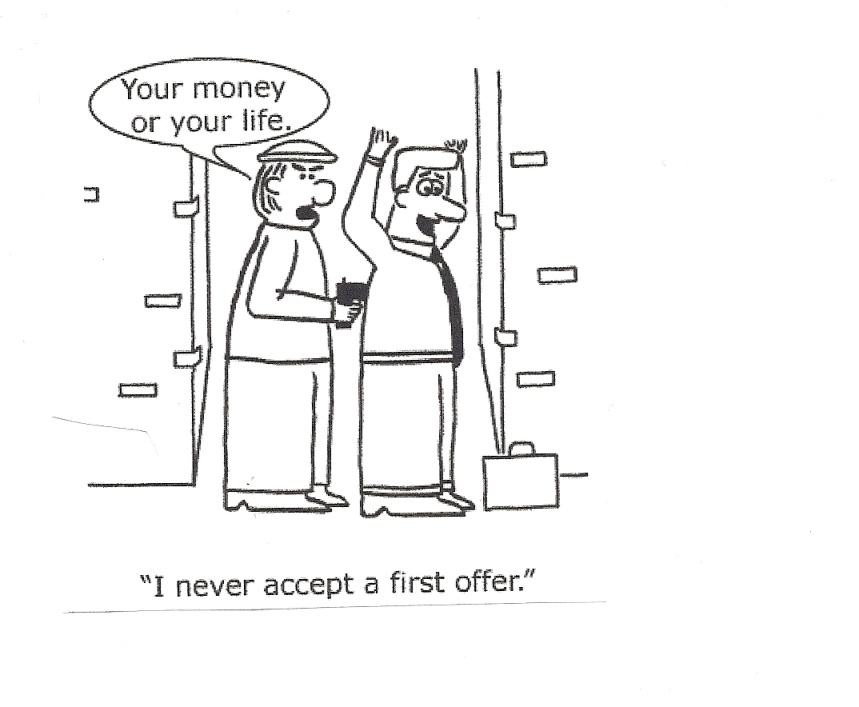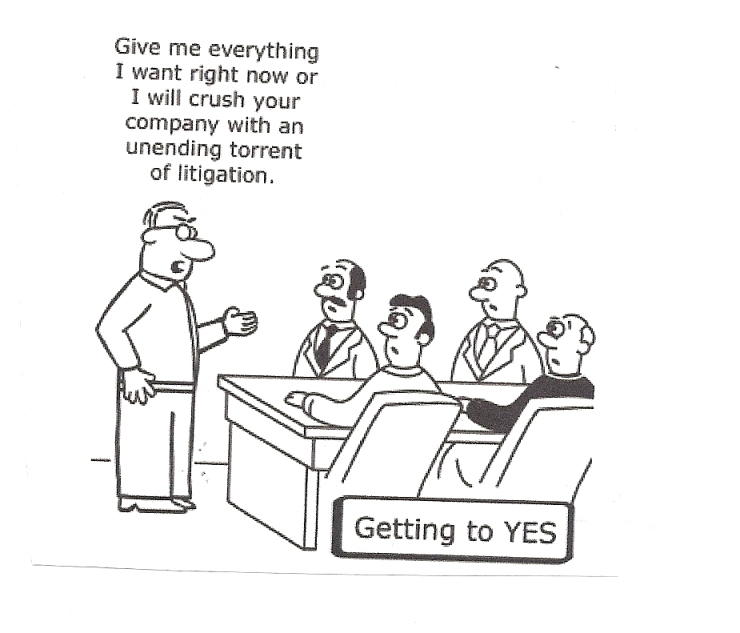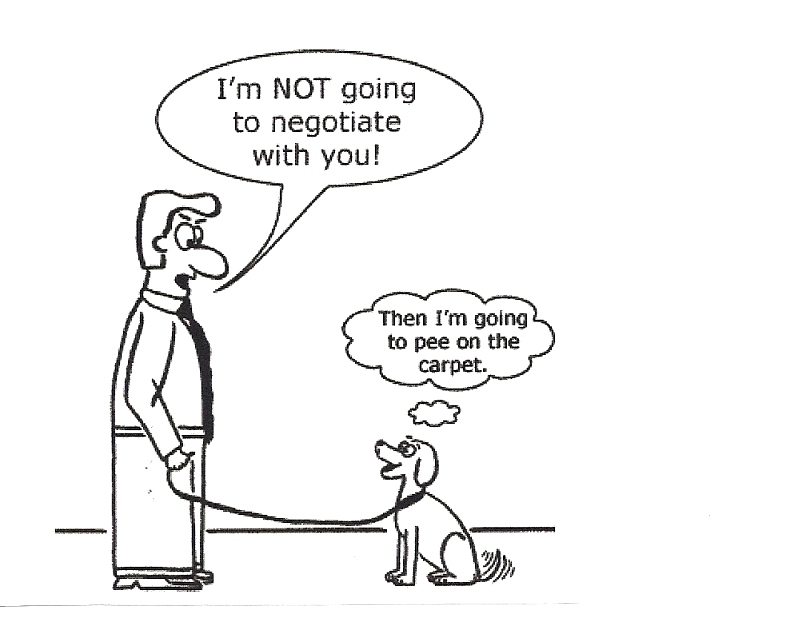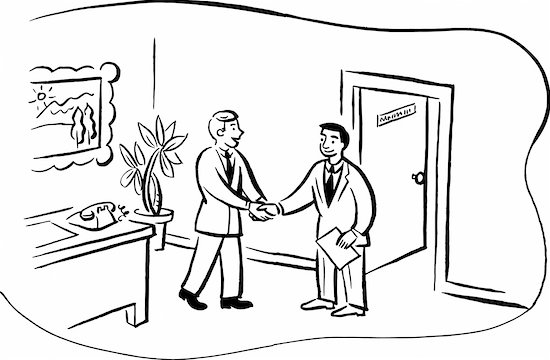
- •Improving Communications
- •Oral communications
- •Written communications
- •7 Tips to become a Good Conversationalist
- •Six Common Mistakes That Spoil Conversations
- •1. Blabbermouthing
- •2. The "take-away" and "me-too" syndrome
- •3. Unsolicited advice
- •4. Interrupting
- •5. Contradicting
- •6. Stingy contributors
- •8 Правил знайомства з діловими партнерами
- •18 Ways to improve your body language
- •6 Чарівних букв
- •Voice and Language
- •Visual aids
- •Fail to prepare
- •No weak opening
- •When I know I have to make a presentation, even a small one before a very limited number of people, I start feeling nervous…
- •When a big meeting is coming up, one that will involve a number of presentations from a range of people…
- •I would say my ability as a presenter is…
- •While I am up on stage, I…
- •Comments about my presentations are generally…
- •If I have to go “off the cuff”…
- •If I could describe public speaking as a food, it would be…
- •Visual aids versus handouts
- •Я к вдало провести ділову зустріч.
- •Introducing the Agenda
- •Introducing the First Item on the Agenda
- •1. What is the desired outcome of the meeting? (How will you know the meeting was successful?)
- •2. Who needs to be there? (And who doesn’t?)
- •3. Is the agenda prepared? (If not now, when?)
- •4. What can I do to prepare? (How can I help others prepare?)
- •5. What can I do to make this meeting succeed? (What is my responsibility?)
- •Discuss the following questions:
- •Exercise 6
- •Negotiating
- •Well, we could make it 7,5 % .
- •The trouble is, the general manager isn't very interested in marketing. He's only concerned about …..5…... If you make it 10%, I might be able to persuade him.
- •But you said…
- •6 Найпоширеніших помилок при проведенні переговорів
- •Communicating with someone in writing
- •The salutation
- •The subject title
- •The body of the letter
- •The parting
- •The signature
- •Inquiries (Enquiries)
- •Поради при написанні ділових листів
- •……………: Always proofread and edit your letters.
- •Avoid the use of …..1….. Words
- •Informal Style Formal Style
- •Identify yourself, if necessary
- •Include necessary information
- •Ten keys to writing an essay
- •Budget your time carefully
- •Read the topic carefully
- •Plan your essay before you write
- •Be sure your handwriting is as clear and legible as possible
- •Follow a clear, logical organization
- •Topic Type a: Contrast/Opinion
- •Use concrete examples and specific reasons
- •Use signal words to indicate transitions
- •Use a variety of sentence types.
- •Check your essay for errors.
- •Електронна пошта
- •Chief, Guy, Sport
- •My Buddy
- •Assumption Junction
- •Peak-a-Boo
- •2 (Suggested answer)
- •Listening 4
- •Contents
- •References
Exercise 6
Look at the cartoons below. Give your comments. Discuss with your partner what negotiations techniques are used?
|
|
|
|
Exercise 7
Fill in the gaps with a suitable word from the box.
relationship listener objectives interests gains face view position problems tenacity hand negotiators atmosphere research concessions rapport |
What makes a good negotiator?
There has been a great deal of …1… into the art of negotiation, and, in particular, into what makes a ‘good’ negotiator.
One point most researchers seem to agree on is that good …2… try to create a harmonious …3… at the start of a negotiation. They make an effort to establish a good …4… with their opposite number, so that there will be a willingness – on both sides – to make …5…, if this should prove necessary.
Good negotiators generally wish to reach an agreement, which meets the …6… of both sides. They therefore tend to take a long-term …7…, ensuring that the agreement will improve, or at least, not harm their …8… with the other party. On the other …9…, a poor negotiator tends to look for immediate …10…, forgetting that the real benefits of a deal may come much later.
Skilful negotiators are flexible. They do not ‘lock themselves’ into a …11… so that they will lose …12… if they have to compromise. They have a range of …13…, thus allowing themselves to make concessions. Successful negotiators do not want negotiation to break down. If …14… arise, they suggest ways of resolving them. The best negotiators are persuasive, articulate people, who select a few key arguments and repeat them. This suggests that …15… is an important quality.
Finally, it is essential to be a good …16… and to check frequently that everything has been understood by both parties.
Exercise 8
Negotiating tactics
During negotiations at the height of the Cold War, Americans were amazed when the Soviet leader Nikita Kruscev became so angry that he started banging his shoe on the table. However, photographs taken at the time show that while he did this, both of his shoes were still on his feet. What does this tell about Kruscev’s negotiating tactics? |
|
Here are five tactics often used in negotiating. Match each tactic to its description below.
The deadline
Bullying
Apeal to a higher authority
Scarcity
A last-minute claim
Saying that only your boss can offer the concession that is being asked for.
Applying pressure by saying that you have to leave at a certain fixed time.
A demand which is made after it appears that agreement has been reached.
An aggressive demand for a concession to be made.
Saying that this is your only chance to buy the product or service.
There are three types of negotiators: the fighter, the creative negotiator and the one who looks for independent advantage.
To find out which one you are, answer the following questions and check your answers with the key at the end.
What type of negotiator are you?
1. Your aim in a negotiation is …
to find the greatest area of agreement in the join interests of both parties.
to win and to make the other side lose.
to find the best deal for your side.
2. When the other side is talking you …
use the information you are hearing to identify weaknesses in the other party.
plan what you are going to say next.
listen with maximum attention.
3. You think that …
part of the available time must be spent socializing and getting to know the other side.
goodwill is important but the speed of the meeting should be quick and businesslike.
the meeting should get down to business as soon as possible and reach quick decisions.
4. When you speak in a negotiation you …
make bold and forceful statements, possibly banning the table.
make carefully considered statements in a calm, controlled voice.
are occasionally forceful and inflexible.
5. If the other side disagrees with you, you
try hard to find a creative position by modifying your position.
repeat your demands and will not concede – your objective is to make another side give in.
reshape your offer without fundamental changes.
6. If the other side states an opinion you disagree with, you…
tentatively suggest an alternative.
ask for clarification and explanation.
ridicule it with sarcasm.
To see which kind of negotiator you are, calculate your total based on the following system:
1 2 3 4 5 6 |
a) 3 a) 1 a) 3 a) 1 a) 3 a) 3 |
b) 2 b) 2 b) 2 b) 3 b) 1 b) 2 |
c) 2 c) 3 c) 1 c) 2 c) 2 c) 1 |
If your score is 15 or more you are a creative negotiator. 11-14 you negotiate to independent advantage. 7-10 you are a fighter! Less than 7 you should get a gun licence.
1. Listen to five experienced negotiators talking about strategy and answer the questions.
Speaker 1
Speaker 2
Speaker 3
Speaker 4
Speaker 5 |
What does T.I.E. stand for?
How can a friendly attitude be counter-productive?
Why is silence more powerful than talking?
How do you avoid pointless debate?
What are the two most useful phrases in negotiation?
What did the Huthwaite Research Group discover?
The speaker mentions three things it’s better to phrase as questions. What are they? |
2. Discuss the meaning of the following idioms with a partner.
Give them an inch and they’ll take a mile.
Play your cards close to your chest.
Don’t take ‘no’ for an answer
![]()
Translate the article into Ukrainian
Win - Win Negotiation Style
In every negotiation, no matter if you buy or sell, solve conflicts or negotiate your salary there is always something lying behind the negotiation, something that motivates people to sit down at the same table to negotiate. In business and everyday life, each of us has something that drives us towards our desires, goals and aspirations. This drive makes us behave in a particular way, adapt particular poses and use different negotiation styles. Typically speaking, personalities of negotiators are visible through observing their approach to negotiation. There are three main approaches:
win-win
win-lose
lose-lose
A win-lose attitude means a competitive approach to the negotiation/purchasing process. An example is when a buyer wants the lowest possible price even when a seller will lose money and conversely a seller wants to drive the price up because he is looking to maximize his profit. This approach will be supported with some manipulative and quite possibly dirty tactics. For people using this kind of orientation, relationship doesn’t matter. A substantive outcome is what counts.
The best possible and desirable situation is when the other side is eager to achieve a mutually satisfactory outcome - win- win. In this case, the other side will be willing to cooperate in order to gain some of his/her goals but also to let us achieve some of ours. There are always some issues in terms of price, quantity, delivery dates or guarantee but there is also a way to match and solve them through reasonable concessions and decisions. Of course, both parties must be willing to do this. If this spirit of mutual satisfaction is not in evidence, it will turn the negotiation into a lose-win or lose-lose competition. If we negotiate with a spirit of cooperation, we may even have a chance to create a value added solution that will benefit both parties more than was considered before the negotiation began.
![]()
|
THE LANGUAGE OF NEGOTIATIONS
|
Pre-reading
Answer the questions below, then read the text and check your answers.
What language do English speakers, especially Americans, use during a negotiation?
How do they show respect in English? Can you give some examples?
In this section you will learn expressions which can be used in negotiations. The expressions are grouped into 6 categories. These categories are built upon a strategy for negotiating that is neither "hard" nor "soft" but both hard and soft. It is the method of principled negotiation developed by the Harvard Negotiation Project at Harvard University. Its goal is to decide issues on their merits and not on the stated positions of the two sides. It suggests that you look for mutual gains wherever possible, and that where your interests conflict, you should insist that the result be based on some fair standards independent of the will of either side.
A note on language style:
English speakers, especially Americans, like to express a certain amount of informality as soon as possible. Therefore, they quickly move to first names (although this is NOT a sign of intimacy or friendship). In addition, they quickly begin to use informal language. These facts are intended to signal cooperation among equal partners.
How can they do this when using first names and informal expressions? They show respect in English in the following ways:
Use would like rather than want when making requests. It's more indirect and, therefore, is more polite and respectful.
I want to hear you talk about that first point again. (This could sound too much like a demand.)
I would like to hear you talk about that first point again. (This is safer.)
Use "should", "could", or "might" to remind or inform people about what to do next. Without such words, you could sound too much like a teacher or a policeman.
Use phrases like "I think" and "maybe" and "perhaps" to introduce suggestions. These words do not indicate uncertainty; they do express respect for the other person.
It's time to start the meeting now. (This COULD sound too authoritarian.) I think we should start the meeting now. (This is safer.)
I'll give you some background information about that. (This is okay if your VOICE sounds helpful.)
Perhaps I could give you some background information about that. (This is safer.)
Use QUESTIONS to make suggestions. Keep in mind, however, that you are not asking for permission, but you are showing the other person respect by giving him or her a chance to disagree or interrupt before you go on.
So, can we go on to the next point now? So, are we finished with that point? If so, let's go on to the next one.
NOTE: The better you get to know someone, the less important these strategies become. People who know each other well (and who respect each other) can be much more direct in saying what they want and what they think.
Here are phrases used in negotiations
![]()
1 Opening the Negotiations |
Welcoming: On behalf of … I would like to welcome you to … It’s my pleasure to welcome you to … Welcome to …
|
Suggesting a procedure: I would like to begin by suggesting the following procedure (agenda). To start with, I think we should establish the overall procedure. As our first order of business, can we agree on a procedure? |
Checking for agreement: Does that fit in with your objectives? Is that compatible with what you would like to see? Does that seem acceptable to you? Is there anything you’d like to change? Is this okay with you?
|
Giving the discussion leadership to a colleague: I will now hand you over to Mr. Adams, who is … I will now hand the floor to Mr. Adams, who is … Now let me hand the meeting over to my colleague, Ms. Jones, who … |
General outline of a proposal: May I ask, please, what your proposal is in connection with our company? What in general terms are you looking for here? |
Dealing with digressions: May we leave that till later and first look at… Can we deal with …first?
|
2 Clarifying Proposals |
Reviewing the previous session: At our last meeting we discussed… Perhaps you will recall that during our last discussion we decided that … |
Moving on to the next point: Could we now move on to the next subject, which is … Let’s go on to the next subject, shall we?
|
Putting forward future possibilities: We foresee … We envisage … We see …
|
Seeking clarification: Could you clarify one point for me? I’m not sure I fully understand your point. What exactly do you mean by…? Could you be more specific? |
Defining a proposal more specifically: It involves … It covers … It includes … It leaves out … |
Reassuring: Let me reassure you that … I can promise you that … Have no doubts that we will … |
Going Beyond Positions to the Underlying Interests Asking why: Why would you want to …? What would you do with …? What is the reason for wanting to …? |
Asking why not: Why couldn’t you …? What would be wrong with doing this? Why would you object to …?
|
3 Exploring the Zone of Bargaining and Options |
Summarizing positions up to this point: Can we summarize your position up to this point? Would you care to summarize your position up to this point? |
Confirming a negotiating position: Is that an accurate summary of where you stand? Would you say that is a fair representation of your position? |
Probing / Looking for options: Just for the sake of argument, what if … Can I ask a hypothetical question? Suppose that … |
|
4 Bargaining |
Signaling the start of bargaining: We’ve looked at what you have proposed, and we are ready to respond. After serious consideration, we are prepared to respond to your proposal.
|
Responding to a proposal: Regarding your proposal, our position is … Our basic position is … As far as your proposal is concerned, we think that … |
Making and qualifying concessions: We would be willing to … , provided, of course, that … We’d be prepared to …. . However, there would be one condition.
|
Making counter proposals: May we offer an alternative? We propose that … We’d like to make an alternative proposal. We propose that … From where we stand, a better solution might be … |
5 Entering the Critical Phase |
Identifying obstacles: The main obstacle to progress at the moment seems to be … The main thing that bothers us is … One big problem we have is …
|
Analyzing an obstacle: What exactly is the underlying problem here? Let’s take a closer look at this problem. I would like to analyze this situation and get to the bottom of the problem. |
Asking for concessions: In return for this, would you be willing to …? We feel there has to be a trade off here.
|
Declining an offer: I’m afraid your offer doesn’t go far enough. Unfortunately, we must decline your offer for the following reason(s). I’m sorry, but we must respectfully decline your offer. |
Asking for further information: Would you like to elaborate on that? Could you go into more detail on that?
|
|
6 Closing |
Checking: Let’s just confirm the details, then. Let’s make sure we agree on these figures (dates / etc.). Can we check these points one last time? |
Delaying: We would have to study this. Can we get back to you on this later? We’ll have to consult with our colleagues back in the office. We’d like to get back to you on it. |
Accepting: We are happy to accept this agreement. This agreement is acceptable to us. I believe we have an agreement. |
|
![]()
Exercise 1
Choose the most appropriate heading for each group from the list below.
|
|
1……………………………………… We just can’t agree to … … is out of question No, I don’t really think so. I’d rather not … |
5……………………………………... I’ve got to stop you … |
2………………………………………. How’s that then? It depends what you mean when you say … What do you have in mind? Could you run through that again?
|
6……………………………………… What we are looking for … We think … We’d like to … There’s no way … We wouldn’t want to … I guarantee … I was hoping for … |
3………………………………………. Well …, if you … We might be able to make an exception, if you … We’re prepared to …, providing … If you …, I could … I was going to … but what if I were to say …? |
7……………………………………… How does that sound …? How do you feel about …? What do you say …?
|
4……………………………………… Why not? Yes, of course. I agree to … That’s a deal.
|
8………………………………………. Let’s agree …, shall we? How about …? We could … Do you want me to …? I’d like to suggest … |
Exercise 2
Work with your partner. Decide in which part of the negotiation these statements are said? Try to give alternatives to each sentence.
I'm sure that we will have a useful and productive meeting...
I'd like to begin...
May I outline our principle aims and objectives today...
There are three specific areas that we would like to discuss.
Together we want to develop a good relationship...
I'd like to finish there and give you the opportunity to reply to this...
We want to clarify our position.
We agree...
Can we run through what we've agreed?
So, the next step is...
We need to draw up a formal contract.
Let's think about the last issue.
As long as you... we agree to...
Could we tie this agreement..?
That's not acceptable unless...
I think we should look at the points that we agree on...
We hope that you can see our point.
I think that you should look at the whole package not so much at individual
areas of difficulty.
It's been a very useful and productive meeting.
It would be better if we looked for an individual arbitrator.
Exercise 3
Work with your partner. Insert the missing parts, then act out the dialogue.
a) five laptops b) his own budget c) 6 months' time d) no worries e) in mind
|
f) your listed prices g) the latest models h) a hard bargain i) potential customers j) the full price |
k) a demonstration model l) at a loss m) a reasonable trade-in deal n) two special customers |






